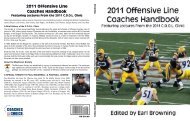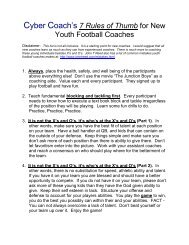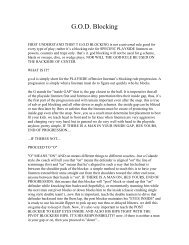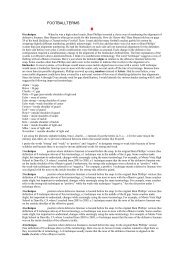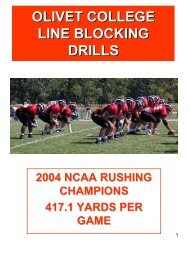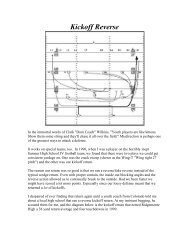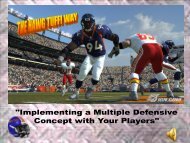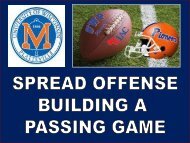You also want an ePaper? Increase the reach of your titles
YUMPU automatically turns print PDFs into web optimized ePapers that Google loves.
Zone Blocking<br />
Part II: Footwork,<br />
Blocking Schemes<br />
Ken Wilmesherr<br />
Offensive Line Coach<br />
Grossmont College<br />
kwilmesh@cox.net
Inside and Outside Zone<br />
W<br />
E T<br />
M<br />
This power point is protected by copyright laws of the United States. Any unauthorized reproduction of this power point<br />
without the expressed written consent of Ken Wilmesherr and Grossmont College is strictly prohibited. Copyright © 2006.<br />
all rights reserved.<br />
N<br />
E<br />
S
<strong>ZONE</strong><br />
FOOTWORK
FOOTWORK<br />
The 1 st step is a directional step. The 2 nd step is a power step<br />
with the emphasis getting it on the ground as soon as possible.<br />
The footwork for zone is different than most other offensive<br />
plays. The tighter the down defenders alignment the tighter the<br />
steps.<br />
Offensive linemen will step simultaneously taking<br />
either a 6-inch lateral jab step (set to drive directional step) or a<br />
bucket step with an angle of departure at 45 degrees (set to<br />
reach directional step) to the left or right when executing the<br />
footwork for the zone play. All linemen need to maintain their<br />
directional track.
STEPS:<br />
FOOTWORK<br />
Covered steps for covered linemen on inside zone.<br />
6-inch lateral jab step (set to drive).<br />
Uncovered steps for uncovered linemen on inside zone.<br />
Bucket step angle of departure 45 degrees (set to reach).<br />
Steps for linemen on outside zone.<br />
All linemen will bucket step (set to reach).
UNCOVERED<br />
STEPS
UNCOVERED STEPS for<br />
UNCOVERED LINEMEN<br />
A wide defender (covered playside). An uncovered lineman in<br />
the zone concept.<br />
First step is a bucket step (set to reach); the angle of departure<br />
is 45 degrees. The angle of departure will not change, but the<br />
depth of the bucket step will depending on the alignment of the<br />
down defender. The hip will open at a 45 degree angle to the<br />
sideline. The target will open the hip to a 45 degree angle.<br />
Second step is a vertical step to and through the defenders<br />
crotch (knee to and through the crotch). The speed of the<br />
second step is so important.<br />
Third step will square the offensive linemen up field.
We speak in terms of “losing ground to gain<br />
ground” for uncovered linemen.<br />
UNCOVERED STEPS for<br />
UNCOVERED LINEMEN<br />
Losing ground to gain ground allows the uncovered<br />
linemen to get on the proper angle to make the block.<br />
UNCOVERED STEPS<br />
2 3<br />
1<br />
Angle of departure 45 degrees
COVERED<br />
STEPS
COVERED STEPS for COVERED<br />
LINEMEN<br />
First step is a 6-inch lateral jab step (set to drive) with the call<br />
side foot.<br />
Second step is a vertical step to and through the down defenders<br />
crotch (knee to and through the crotch). The lineman’s base will<br />
narrow slightly. It is important to get the second step in the<br />
ground as soon as possible. The speed of the second step is<br />
important.<br />
Third step will square the offensive lineman up field. It is<br />
important to keep the shoulders square.
COVERED STEPS for COVERED<br />
LINEMEN<br />
COVERED STEPS<br />
2<br />
3<br />
1<br />
6-inch lateral jab step<br />
to gain width
FOOTWORK<br />
OUTSIDE<br />
<strong>ZONE</strong>
FOOTWORK OUTSIDE <strong>ZONE</strong><br />
On outside zone all linemen will take uncovered steps.<br />
First step is a bucket step (set to reach). Angle of departure is<br />
at a 45 degrees. The target will put lineman at a 45 degree<br />
angle.<br />
Second step is an outside reach step trying to step on the outside<br />
toes of the defender.<br />
Third step will square the offensive linemen.<br />
Linemen are trying to rip the funnel. The funnel is the elbow,<br />
ribs, and arm pit of the defender.<br />
BUCKET, CROSS OVER, RIP.
FOOTWORK OUTSIDE <strong>ZONE</strong><br />
We speak in terms of “losing ground to gain<br />
ground” for uncovered linemen.<br />
Losing ground to gain ground allows the uncovered<br />
linemen to get on the proper angle to make the block.<br />
FOOTWORK OUTSIDE <strong>ZONE</strong><br />
2<br />
1<br />
3<br />
Angle of departure 45 degrees
TECHNIQUE,<br />
CALLS for<br />
UNCOVERED<br />
LINEMEN
It is imperative that uncovered linemen understand the down<br />
defenders alignment (inside technique, headed up, technique or<br />
outside technique) on the playside or call side covered lineman.<br />
W<br />
E T<br />
vs. a 2i technique<br />
2i, 4i, 7 tech call, there is a greater chance (80%) the uncovered<br />
linemen will end up blocking the inside shaded defender (inside<br />
shaded alignment) unless the defender sparks or buffs.
0, 2 ,4, 6 tech call, there is a half the chance (50%) the<br />
uncovered lineman will end up blocking the head up<br />
defender technique (head up alignment). The defender<br />
can slant to either gap from a head up alignment.<br />
W<br />
E T<br />
vs. a 2 technique<br />
3, 5, 9 tech call, there is a slight chance (20%) the uncovered<br />
lineman will end up blocking the 3, 5, or 9 technique (outside<br />
shaded alignment) unless the defender sparks or buffs.<br />
W<br />
E T<br />
vs. a 3 technique
TECHNIQUE CALLS<br />
DEFENSIVE MOVEMENT:<br />
Buff: a stunt angled movement away from where the defender<br />
is aligned.<br />
T<br />
BUFF<br />
T<br />
Slant: a stunt to a specific gap from a head up alignment.<br />
T SLANT<br />
T
TECHNIQUE CALLS<br />
DEFENSIVE MOVMENT:<br />
Spark: a stunt angled by a defensive lineman aiming at the<br />
ear hole of the offensive lineman to his inside or outside.<br />
T T<br />
SPARK
THIN and<br />
THICK<br />
CALLS
THIN & THICK<br />
Covered linemen will make a “thin” or “thick” calls. These<br />
calls are determined by the LB’s alignment at depth. For<br />
example, if the defensive structure is a 4-3, the center will<br />
make a defensive recognition call to alert the entire line. The<br />
backside guard will then make a co-op call to alert the<br />
backside tackle. The covered lineman will make a “thick” or<br />
“thin” call at the L.O.S..<br />
E T<br />
“THIN”<br />
W W<br />
E T<br />
“THICK”
THICK<br />
“Thick” call the backside tackle and guard are blocking the 2<br />
or 3 techniques to the WILL LB (4i at depth), the WILL is<br />
thick on the 2 or 3 techniques (the WILL is stacked on the<br />
END or in the C gap on the backside) the backside guard<br />
will hang getting vertical push on the down defender (1st<br />
level defender) creating a double team until the WILL LB<br />
commits.<br />
W<br />
E T<br />
WILL LB is thick<br />
BST & BSG “Thick Call”
THIN<br />
“Thin” call the WILL LB (3 technique at depth) is splitting<br />
the crotch or stacked over the 2 or 3 technique, the guard<br />
will make a thin call to alert the tackle that he will not hang<br />
on the 1st level defender. The footwork will also change<br />
on a thin call the guard will take uncovered steps.<br />
WILL LB is Thin MIKE LB is Thick<br />
W M<br />
E T T<br />
BST & BSG “Thin Call”/ C & PSG “Thick Call”
THIN & THICK<br />
If the linebacker is aligned over the call side linemen he will<br />
make a thin call to alert the backside lineman he will have very<br />
little to no help on the down defender. Both linemen will<br />
execute a bucket (set to reach) step aiming for the call side<br />
shoulders of the defenders.<br />
If the linebacker is aligned over the backside lineman the call<br />
side lineman will make a thick call and hang on the down<br />
defender one arm benching, maintaining pressure and inside<br />
leverage as both linemen work to the second level defender.
CO-OPS
CO-OPS<br />
Co-ops in the zone concept are defined as two or more adjacent<br />
linemen working together on a down defender on level one to<br />
a second defender on level two.<br />
There are playside and backside co-ops.<br />
The line calls start from the call side out and working in to the<br />
backside.<br />
Thin and thick calls are made depending on the alignment of<br />
the second level defender.
BACKSIDE<br />
CO-OPS
BACKSIDE CO-OPS:<br />
CO-OPS<br />
Slug: Backside TE and Backside Tackle.<br />
Buzz: Backside TE and Backside Tackle working to a Safety<br />
on the second level.<br />
Swap: Backside Tackle and Backside Guard.<br />
Scoop: Backside Guard and Center.<br />
Solid: Backside TE, Backside Tackle and Backside Guard.<br />
Trip: Backside Tackle, Backside Guard and Center.
Backside co-op between the Backside TE and the<br />
Backside Tackle. Slug Call.<br />
W<br />
E<br />
SLUG<br />
Backside co-op between the Backside TE and the Backside<br />
Tackle working to a Safety on the second level. Buzz Call.<br />
W<br />
SS<br />
E<br />
BUZZ
Backside co-op between the Backside Tackle and the<br />
Backside Guard. Swap Call.<br />
W<br />
E T<br />
SWAP<br />
Backside co-op between the Backside Guard and the Center.<br />
Scoop Call.<br />
M<br />
N<br />
SCOOP
Backside co-op between the Backside TE, Backside Tackle<br />
and the Backside Guard. Solid Call.<br />
M<br />
W<br />
E T<br />
SOLID<br />
Backside co-op between the Backside Tackle, Backside Guard<br />
and the Center. Trip Call.<br />
E T<br />
W<br />
N<br />
TRIP
PLAYSIDE<br />
CO-OPS
PLAYSIDE CO-OPS:<br />
CO-OPS<br />
Single: Center and Playside Guard.<br />
Double: Playside Guard and Playside Tackle.<br />
Triple: Playside Tackle and Playside TE.<br />
Gang: Backside Tackle, Backside Guard, Center, and Playside<br />
Guard.<br />
Trio: Playside Guard, Center, and Backside Guard.<br />
Triplet: Playside Guard, Playside Tackle, and Playside TE.
Playside co-op between the Center and the Playside Guard.<br />
Single Call.<br />
M<br />
T<br />
SINGLE<br />
Playside co-op between the Playside Guard and the Playside<br />
Tackle. Double Call.<br />
N<br />
M<br />
E<br />
DOUBLE
Playside co-op between the Playside Tackle and the<br />
Playside TE. Triple Call.<br />
S<br />
T E<br />
TRIPLE<br />
Playside co-op between the Backside Tackle, Backside<br />
Guard, Center, and Playside Guard. Gang Call.<br />
T<br />
M<br />
N<br />
T<br />
GANG
Playside co-op between the Backside Guard, Center, and<br />
Playside Guard. Trio Call.<br />
M<br />
N<br />
TRIO<br />
Playside co-op between the Playside Guard, Playside Tackle,<br />
and the Playside TE. Triplet Call.<br />
N<br />
M<br />
E<br />
T<br />
S<br />
TRIPLET
<strong>ZONE</strong><br />
SCHEMES
SCHEME<br />
Scheme is defined as a<br />
combination of blocks in<br />
either the running game or<br />
passing game.
WEAK<br />
<strong>INSIDE</strong> <strong>ZONE</strong><br />
vs. 5-3
WEAK <strong>INSIDE</strong> <strong>ZONE</strong><br />
<strong>Vs</strong>. 5-3<br />
TE: Set to Reach; (Buzz call) with the Tackle<br />
SST: Set to Drive; “Thick” (Buzz call) with TE<br />
SSG: Set to Drive; (Scoop call) with Center<br />
C: Set to Reach; “Thick” (Scoop call) with SSG<br />
BSG: Set to Drive; maintain inside leverage<br />
BST: Set to Drive; maintain inside leverage
W<br />
WEAK <strong>INSIDE</strong> <strong>ZONE</strong><br />
E T<br />
<strong>Vs</strong>. 5-3<br />
M<br />
N<br />
T<br />
SS<br />
S
W<br />
WEAK <strong>INSIDE</strong> <strong>ZONE</strong><br />
E T<br />
<strong>Vs</strong>. 5-3<br />
M<br />
N<br />
T<br />
SS<br />
S
W<br />
WEAK <strong>INSIDE</strong> <strong>ZONE</strong><br />
E T<br />
<strong>Vs</strong>. 5-3<br />
M<br />
N<br />
T<br />
SS<br />
S
W<br />
WEAK <strong>INSIDE</strong> <strong>ZONE</strong><br />
E T<br />
<strong>Vs</strong>. 5-3<br />
M<br />
N<br />
T<br />
SS<br />
S
W<br />
WEAK <strong>INSIDE</strong> <strong>ZONE</strong><br />
E T<br />
<strong>Vs</strong>. 5-3<br />
M<br />
SCOOP BUZZ<br />
N<br />
T<br />
SS<br />
S
OUTSIDE<br />
<strong>ZONE</strong> vs. 4-3
OUTSIDE <strong>ZONE</strong><br />
<strong>Vs</strong>. 4-3<br />
TE: Set to Reach; (Triple call) with the Tackle<br />
SST: Set to Reach; (Triple call) with TE<br />
SSG: Set to Reach; (Single call) with Center<br />
C: Set to Reach; (Single call) with SSG<br />
BSG: Set to Reach; (Swap call) with BST<br />
BST: Set to Reach; (Swap call) with BSG
W<br />
E T<br />
OUTSIDE <strong>ZONE</strong><br />
<strong>Vs</strong>. 4-3<br />
M<br />
T<br />
S<br />
E
W<br />
E T<br />
OUTSIDE <strong>ZONE</strong><br />
<strong>Vs</strong>. 4-3<br />
M<br />
T<br />
S<br />
E
W<br />
E T<br />
OUTSIDE <strong>ZONE</strong><br />
<strong>Vs</strong>. 4-3<br />
M<br />
T<br />
S<br />
E
W<br />
E T<br />
OUTSIDE <strong>ZONE</strong><br />
<strong>Vs</strong>. 4-3<br />
M<br />
T<br />
S<br />
E
W<br />
E T<br />
OUTSIDE <strong>ZONE</strong><br />
<strong>Vs</strong>. 4-3<br />
M<br />
T<br />
S<br />
E
W<br />
E T<br />
OUTSIDE <strong>ZONE</strong><br />
<strong>Vs</strong>. 4-3<br />
M<br />
SWAP SINGLE TRIPLE<br />
T<br />
S<br />
E
<strong>INSIDE</strong> <strong>ZONE</strong><br />
vs. 4-3
<strong>INSIDE</strong> <strong>ZONE</strong><br />
<strong>Vs</strong>. 4-3<br />
TE: Set to Drive; “Thick” (Triple call) with the Tackle<br />
SST: Set to Reach; (Triple call) with TE<br />
SSG: Set to Drive; “Thick” (Single call) with Center<br />
C: Set to Reach; (Single call) with SSG<br />
BSG: Set to Drive; “Thick” (Swap call) with BST<br />
BST: Set to Reach; (Swap call) with BSG
W<br />
E T<br />
<strong>INSIDE</strong> <strong>ZONE</strong><br />
<strong>Vs</strong>. 4-3<br />
M<br />
T<br />
S<br />
E
W<br />
E T<br />
<strong>INSIDE</strong> <strong>ZONE</strong><br />
<strong>Vs</strong>. 4-3<br />
M<br />
T<br />
S<br />
E
W<br />
E T<br />
<strong>INSIDE</strong> <strong>ZONE</strong><br />
<strong>Vs</strong>. 4-3<br />
M<br />
T<br />
S<br />
E
W<br />
E T<br />
<strong>INSIDE</strong> <strong>ZONE</strong><br />
<strong>Vs</strong>. 4-3<br />
M<br />
T<br />
S<br />
E
W<br />
E T<br />
<strong>INSIDE</strong> <strong>ZONE</strong><br />
<strong>Vs</strong>. 4-3<br />
M<br />
T<br />
S<br />
E
W<br />
E T<br />
<strong>INSIDE</strong> <strong>ZONE</strong><br />
<strong>Vs</strong>. 4-3<br />
M<br />
SWAP SINGLE TRIPLE<br />
T<br />
S<br />
E
OUTSIDE<br />
<strong>ZONE</strong> vs.<br />
EAGLE WEAK
OUTSIDE <strong>ZONE</strong><br />
<strong>Vs</strong>. Eagle Weak<br />
TE: Set to Reach; Maintain inside leverage, possible Triplet<br />
with Tackle and Guard<br />
SST: Set to Reach; Maintain inside leverage, possible Triplet<br />
with TE and Guard or possible Double with Guard<br />
SSG: Set to Reach; possible Triplet with TE and Tackle or<br />
possible Double with Tackle<br />
C: Set to Reach; (Scoop call) with BSG<br />
BSG: Set to Reach; (Scoop call) with Center<br />
BST: Cut the 3 technique
OUTSIDE <strong>ZONE</strong><br />
W<br />
E T<br />
<strong>Vs</strong>. Eagle Weak<br />
N<br />
M<br />
E S
OUTSIDE <strong>ZONE</strong><br />
W<br />
E T<br />
<strong>Vs</strong>. Eagle Weak<br />
N<br />
M<br />
E S
OUTSIDE <strong>ZONE</strong><br />
W<br />
E T<br />
<strong>Vs</strong>. Eagle Weak<br />
N<br />
M<br />
E S
OUTSIDE <strong>ZONE</strong><br />
W<br />
E T<br />
<strong>Vs</strong>. Eagle Weak<br />
N<br />
M<br />
E S
OUTSIDE <strong>ZONE</strong><br />
W<br />
E T<br />
<strong>Vs</strong>. Eagle Weak<br />
N<br />
M<br />
E S
OUTSIDE <strong>ZONE</strong><br />
W<br />
E T<br />
<strong>Vs</strong>. Eagle Weak<br />
N<br />
M<br />
E S
<strong>INSIDE</strong> <strong>ZONE</strong><br />
vs. EAGLE<br />
WEAK
<strong>INSIDE</strong> <strong>ZONE</strong><br />
<strong>Vs</strong>. Eagle Weak<br />
TE: Set to Drive; Maintain inside leverage<br />
SST: Set to Drive; Maintain inside leverage, possible double<br />
with SSG<br />
SSG: Set to Drive; “Thin” (Single call) with Center, or<br />
possible Double with SST
<strong>INSIDE</strong> <strong>ZONE</strong><br />
<strong>Vs</strong>. Eagle Weak Cont.<br />
C: Set to Reach; (Single call) with SSG or a possible Trip call<br />
with the BSG and BST<br />
BSG: Set to Reach; “Thin” (Swap call) with Tackle or a<br />
possible Trip call with Center and BST<br />
BST: Set to Reach; (Swap call) with BSG or a Trip call with<br />
the Center and BSG
W<br />
E T<br />
<strong>INSIDE</strong> <strong>ZONE</strong><br />
<strong>Vs</strong>. Eagle Weak<br />
N<br />
M<br />
E S
W<br />
E T<br />
<strong>INSIDE</strong> <strong>ZONE</strong><br />
<strong>Vs</strong>. Eagle Weak<br />
N<br />
M<br />
E S
W<br />
E T<br />
<strong>INSIDE</strong> <strong>ZONE</strong><br />
<strong>Vs</strong>. Eagle Weak<br />
N<br />
M<br />
E S
W<br />
E T<br />
<strong>INSIDE</strong> <strong>ZONE</strong><br />
<strong>Vs</strong>. Eagle Weak<br />
N<br />
M<br />
E S
CONTACT INFORMATION<br />
KEN WILMESHERR<br />
OFFENSIVE LINE COACH<br />
GROSSMONT COLLEGE<br />
8800 GROSSMONT COLLEGE DRIVE<br />
EL CAJON, CA 92020-1799<br />
kwilmesh@cox.net<br />
Copyright © 2006, Ken Wilmesherr and Grossmont College.<br />
All rights reserved



